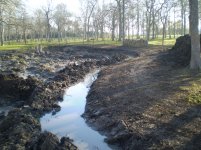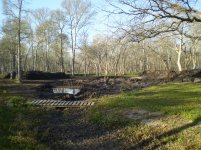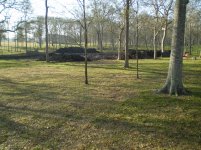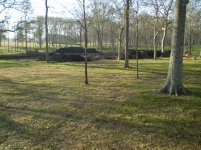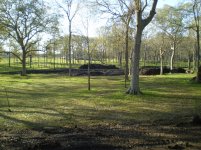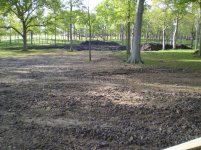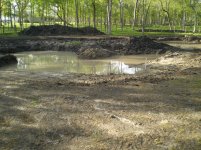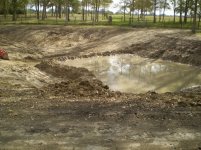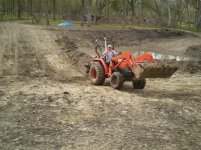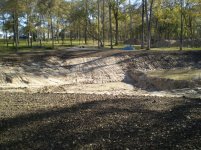You are using an out of date browser. It may not display this or other websites correctly.
You should upgrade or use an alternative browser.
You should upgrade or use an alternative browser.
Build A Pond?
- Thread starter ctpres
- Start date
- Views: 128309
More options
Who Replied?
/ Build A Pond?
#101
Project status: Topsoil removal done, lots of dirt ready to be moved, waiting for trailer, east side ready for grass, stream diverted to east side. Pic one shows east side of pond ready for buffalo grass planting and maybe a few landscape plants. Also can see temporay new stream bed. I diverted water flow to a narrow channel on the east side. If we don't get a lot of rain the rest of the pond should dry up so I can start working on the bottom. Pic two is just finished west side. Bit hard to see depth untill you see the drive out ramp on the far end. Pic three is whole project viewed from upstream side. Pic four is view from house. Not much to see from house but a lot of dirt. So far this is still fun.
Attachments
EddieWalker
Epic Contributor
Looks like you're coming right along. I like how nice the shoreline is looking and can see where it's going to look very natural with the shape you are making it.
Eddie
Eddie
Looks like you're coming right along. I like how nice the shoreline is looking and can see where it's going to look very natural with the shape you are making it.
Eddie
Thank You Eddie! I didn't want any straight shorelines. I'm just doing this as I go and trying to think each step thru. Havn't even finished yet and starting to work on landscaping.
One more thing to learn and I wasn't expecting this one. Spread dirt and plant grass. Well not that easy. The biggest problem is moisture content while working the dirt. Digging resulted in many large clumps, some one third bucket size even after moving to new location. Day one and more, can't pack dirt as it is still to moist, it just squishes out around tires making a bigger mess and if I wait to long the clumps get hard as rocks making the packing process a multi pucker operation trying to drive over the bigger clumps. Once packed another wait and test daily cycle looking for a good day to box blade and even things up, if I pack to much and then wait to long, everything is hard as a concrete and the box blade just skips over the surface.
After box blade yet another wait and test cycle looking for a good day to disc. And all this with no rain to complicate maters.
Since this is such a big project, every day I end up with four or five areas to work with dirt in totally different moistue conditions and three implements on the back end and each implement needs to be adjusted at least once.
Summary-digging is easy, moving is easy, for me this is the hard part.
After box blade yet another wait and test cycle looking for a good day to disc. And all this with no rain to complicate maters.
Since this is such a big project, every day I end up with four or five areas to work with dirt in totally different moistue conditions and three implements on the back end and each implement needs to be adjusted at least once.
Summary-digging is easy, moving is easy, for me this is the hard part.
EddieWalker
Epic Contributor
It sounds like you are discovering those things that you never think about, and nobody remembers to talk about. Dirt is a funny thing, and it sure does behave differently depending on how much water it has. I try to spread it out with every load to the best of my ability, but to also keep on moving as quickly as possible. The inital loads will all become covered quickly enough, so it's the in final finish that I'm thinking about. When I start getting close to that,I really slow down and spend more time on it.
If the dirt is too hard to mess with after it dries out, I'd probably leave it alone for now. Rain will come again and soften it up for you. It's just a matter of timing when you can get back at it and how quickly it hardens up on you again.
I've also found that there is a crust on clay when it hardens, but once you break it, the soil below that crust is soft and very managable. I've had issues with breaking the crust or shell on clay with my 40,000 pound dozer!!!
Keep at it, we're enjoying your progress.
Eddie
If the dirt is too hard to mess with after it dries out, I'd probably leave it alone for now. Rain will come again and soften it up for you. It's just a matter of timing when you can get back at it and how quickly it hardens up on you again.
I've also found that there is a crust on clay when it hardens, but once you break it, the soil below that crust is soft and very managable. I've had issues with breaking the crust or shell on clay with my 40,000 pound dozer!!!
Keep at it, we're enjoying your progress.
Eddie
radioman
Super Member
perhaps this is the reason why most pond diggers just pile dirt near edge of pond. Lets the soil drain. Once its been sitting there for a week, Digging back into the pile will still show moist soil under the outer layer allowing you to pack it down where you move it to final location but not too wet wher eit squishes and makes a big mess. I admire you to work in those muddy conditions though. :thumbsup:
This a really big problem for a small tractor. My best solution breaking the crust has been to work from the top rather than trying to work from the hole. I approach the edge of hole at an angle with about half of bucket in hole and half on top crust. With bucket at 45 degrees or so I get front wheels off ground for max weight on tooth bar teeth, wiggle bucket, then angle buckt less than 45 degree and some forward pressure with rear wheels and repeat process. Each time the teeth go a little deeper and there is some forward travel, front wheel still off ground. Usually breaks off a big chunk on second or third try. Resulting sawtooth edge of hole is finished with same process but bucket parallel to edge. Once desired edge of pond is reached, all I have to do is clean up last sawtooth edge with bucket at angle of desired slope. As Eddie said, once thru clay/gumbo crust the rest is easy.I've also found that there is a crust on clay when it hardens, but once you break it, the soil below that crust is soft and very managable. I've had issues with breaking the crust or shell on clay with my 40,000 pound dozer!!!
Eddie
PS: Put as much weight on rear as you have, I have 400/500 pound block.
Last edited:
This pretty much sums up my problem.
"Soils that are predominantly clay also contain small amounts of silt and sand. Clay soils that
crack excessively while drying are often called "adobe soils." If they are very low in organic
matter, clay soils lose their structure and become cloddy and compact if plowed, stirred, walked
on, or otherwise manipulated when they are too wet. Once a clay soil is badly puddled, it may
take years of careful handling to restore good structure"
Lesson learned and advise for others: KNOW YOUR DIRT before you start a big project.
"Soils that are predominantly clay also contain small amounts of silt and sand. Clay soils that
crack excessively while drying are often called "adobe soils." If they are very low in organic
matter, clay soils lose their structure and become cloddy and compact if plowed, stirred, walked
on, or otherwise manipulated when they are too wet. Once a clay soil is badly puddled, it may
take years of careful handling to restore good structure"
Lesson learned and advise for others: KNOW YOUR DIRT before you start a big project.
Dirt piles are going away ever so slowly. Neighbors that originally wanted some found out how much work it is and have all but stopped. Today or tomorrow a friend with lots of heavy equipment seat time is dropping by to give me some technical help on how to handle the spredding, leveling and seedbed prepration. Must get a lot done before the end on this month as we are leaving for a one month plus RV trip west. Can see some of moved dirt at bottom of picture. So far only spreading around house to smooth out the original pad built up to raise building site. Trying to make it look more natural as opposed to the original pad shaped like house.
Attachments
Last edited:
Thanks to my retired friends (20 years heavy equipment operator) visit today: 1. Now can use a transit good enough to check grading the banks and depth to go in digging. It had been gathering dust in the shop. I had opened the case once to see what was in it-knew I could't figure out how to and just shoved it in a corner over five years ago. 2. He looked around for a couple of minutes and showed me a LOT of places needing fill dirt. 3. Told me to quit making it easy for neighbors by piling dirt in easy to work piles around the edges. Let then dig. 4. Said don't worry any more about stripping any top soil. Just dig down to desired depth till it rains. Then channel any standing water into that hole and start another one next to it. 5. Thinks my diverted channel should be adequate to handle pretty heavy rains limiting work areas to local runoff and direct hit rain. 6. Don't worry so much about staying off of septic field with tractor. Should be no problem when empty on twenty yead old field. And BEST OF ALL thinks it looks pretty good so far. In All a Great Day.
Status report before RV trip.
Will be on the road getting a different kind of seat time for about 45 days.
First picture is water after less than 1/2 inch of rain. I really wasn't expecting it to hold very long as I hit sand around three feet. That's really good news from a digging and spreading standpoint. Just means I'll need to save some of that gumbo to seal the bottom.
Next one is view of dirt spread around back yard. Wasn't really in the plans but that is what I have to look at when we get home. Just couldn't work fast enough to get it ready for grass seed.
Last one is view from edge of pond. For a tinhorn I think I have been doing pretty good at leveling. Still have a lot to learn. Now I really understand the use/need of wheels on BB.
Will be on the road getting a different kind of seat time for about 45 days.
First picture is water after less than 1/2 inch of rain. I really wasn't expecting it to hold very long as I hit sand around three feet. That's really good news from a digging and spreading standpoint. Just means I'll need to save some of that gumbo to seal the bottom.
Next one is view of dirt spread around back yard. Wasn't really in the plans but that is what I have to look at when we get home. Just couldn't work fast enough to get it ready for grass seed.
Last one is view from edge of pond. For a tinhorn I think I have been doing pretty good at leveling. Still have a lot to learn. Now I really understand the use/need of wheels on BB.
Attachments
jinman
Rest in Peace
- Joined
- Feb 23, 2001
- Messages
- 21,059
- Location
- Texas - Wise County - Sunset
- Tractor
- NHTC45D, NH LB75B, Ford Jubilee
It looks like you will have no trouble holding water in that pond.:thumbsup:
The second picture reminds me of a section of my yard that I recently prepared and planted. I've been trying to get a good lawn established from seed, but the progress has been very slow. Two weeks ago, the weather was nice for a couple of days, and the ground was damp. So, I had the tiller on the tractor and decided to see if I could lightly till this area. It went okay with the tilling, but I honestly wouldn't recommend it. Established grass kinda clumped up in the tiller. Anyhow, after tilling, I dragged the area with my chainlink drag and got it pretty smooth. I put down 150 lb of fertilizer over the area (about 4000 sq ft) and then put down 120 lb of fescue, rye, and bermuda seed that I premixed. I have a pull behind spreader for my lawn tractor that worked beautifully. After seeding, I drove back and forth over the area a gazillion times to set the seed into the surface of the soil and kinda pack down the seedbed.
After I finished and had the sprinkler going to water the new seed, I was cleaning up all my fertilizer and grass seed bags when something caught my eye. In one instant, I felt sick at my stomach and pretty darn stupid. The fertilizer bags all clearly said "Weed and Feed" on the bags.:shocked: I had grabbed the wrong bags in my haste at the store and didn't notice until the fertilizer was down. I meant to get 13-13-13 starter fertilizer, but what I got was high nitrogen fertilizer mixed with weed killer that inhibits germination. It's been two weeks now with two rain/snow events and lots of warm weather. I have not seen one single sprig of grass growing from the seed. Of course, the weed killer is still there from the fertilizer, so I can't even get new seed down and expect any success.
The fertilizer bags all clearly said "Weed and Feed" on the bags.:shocked: I had grabbed the wrong bags in my haste at the store and didn't notice until the fertilizer was down. I meant to get 13-13-13 starter fertilizer, but what I got was high nitrogen fertilizer mixed with weed killer that inhibits germination. It's been two weeks now with two rain/snow events and lots of warm weather. I have not seen one single sprig of grass growing from the seed. Of course, the weed killer is still there from the fertilizer, so I can't even get new seed down and expect any success. My bare lawn is hanging around my neck like the proverbial albatross.:ashamed:
My bare lawn is hanging around my neck like the proverbial albatross.:ashamed:
The second picture reminds me of a section of my yard that I recently prepared and planted. I've been trying to get a good lawn established from seed, but the progress has been very slow. Two weeks ago, the weather was nice for a couple of days, and the ground was damp. So, I had the tiller on the tractor and decided to see if I could lightly till this area. It went okay with the tilling, but I honestly wouldn't recommend it. Established grass kinda clumped up in the tiller. Anyhow, after tilling, I dragged the area with my chainlink drag and got it pretty smooth. I put down 150 lb of fertilizer over the area (about 4000 sq ft) and then put down 120 lb of fescue, rye, and bermuda seed that I premixed. I have a pull behind spreader for my lawn tractor that worked beautifully. After seeding, I drove back and forth over the area a gazillion times to set the seed into the surface of the soil and kinda pack down the seedbed.
After I finished and had the sprinkler going to water the new seed, I was cleaning up all my fertilizer and grass seed bags when something caught my eye. In one instant, I felt sick at my stomach and pretty darn stupid.
Dargo
Super Member
- Joined
- Mar 6, 2004
- Messages
- 6,011
- Location
- S. IN
- Tractor
- Jinma, Foton, TYM, Belarus, Yanmar, Branson, Montana, Mahindra and maybe some green and orange too.
Having spent many years destroying the landscape strip mining (I'm glad when reclamation laws were enacted), I've dug through what seems like nearly every condition. The tough layer is what is commonly called "hard pan". I don't know if that's the scientific name, but for 20 years, that's all I knew it by. I haven't read all this thread, but I assume that you know that if you hit rock, stop, start covering that part. Most people who have asked me to help their pond keep water have dug down until they hit limestone.
I've hit the oddest things too. Running a ripper for a week on a D11 dozer to take out a road (easy but very boring job), I hit a spot that stopped me dead in my tracks. Actually whacked my head off the windshield too (yeah, caught me being lazy and not using my seat belt on a flat level road). Called in a 5 yard excavator to dig out whatever stopped me and you'll never guess what it dug up; an old locomotive engine! What the heck was it doing buried about 7 feel under an old county road??? Never figured that one out. We figured it didn't just fly there on it's own. Maybe it was being transported and fell off the trailer and they couldn't get it back on? Dunno. We just re-buried it out of the way but about 50 feet deep this time.
When I dug my lake I had to switch from my personal high lift Cat 955 to borrowing/renting an excavator after I got about 6' deep or so. I was spending more time and energy getting in and out of the pond that progress had tremendously slowed. I think I've posted before that with 3 dump trucks running and me slinging a 2 yard bucket on the excavator, we finished out the pond to a nice 20' depth and out to about an acre and a half in less than a week. All's been great for the last 10 years now. Oh yeah, I set the spillway with a string level as well as the dock. I didn't own a transit at that time. I'm proud to say that I came out within an inch of where I wanted to be using that method. Close enough for me! Good luck!
I've hit the oddest things too. Running a ripper for a week on a D11 dozer to take out a road (easy but very boring job), I hit a spot that stopped me dead in my tracks. Actually whacked my head off the windshield too (yeah, caught me being lazy and not using my seat belt on a flat level road). Called in a 5 yard excavator to dig out whatever stopped me and you'll never guess what it dug up; an old locomotive engine! What the heck was it doing buried about 7 feel under an old county road??? Never figured that one out. We figured it didn't just fly there on it's own. Maybe it was being transported and fell off the trailer and they couldn't get it back on? Dunno. We just re-buried it out of the way but about 50 feet deep this time.
When I dug my lake I had to switch from my personal high lift Cat 955 to borrowing/renting an excavator after I got about 6' deep or so. I was spending more time and energy getting in and out of the pond that progress had tremendously slowed. I think I've posted before that with 3 dump trucks running and me slinging a 2 yard bucket on the excavator, we finished out the pond to a nice 20' depth and out to about an acre and a half in less than a week. All's been great for the last 10 years now. Oh yeah, I set the spillway with a string level as well as the dock. I didn't own a transit at that time. I'm proud to say that I came out within an inch of where I wanted to be using that method. Close enough for me! Good luck!
Jinman: And I felt bad. Wow I am in good shape. If you promise not to eat much, you welcome to come with us. Maybe you can try again in a couple months. Does bag say anything about life of product in the ground?
Dargo: Hardpan-got it. Will stop post hole digger digging like hitting concrete, if you are lucky. Really bad when PHD gets a good bite in the hard pan and goes in a few inches, you probably wont get to the clutch in time to keep engine from stalling. Then you get to go for the pipe wrench and cheater just to back it out. In this situation the high moisture levels keep it soft enough so it's not a problem.
Dargo: Hardpan-got it. Will stop post hole digger digging like hitting concrete, if you are lucky. Really bad when PHD gets a good bite in the hard pan and goes in a few inches, you probably wont get to the clutch in time to keep engine from stalling. Then you get to go for the pipe wrench and cheater just to back it out. In this situation the high moisture levels keep it soft enough so it's not a problem.
Project Update: Sorry for absence, but RIF (retirement is fun.) Have been so busy with RV travels and just enjoying life in genaral that I han't kept my TBN friends uptodate. Digging is almost done. The next rain will probably be the end of digging. Not even finished and we have FISH. Spring rains filled upstream pond and it overflowed thru my project bringing LOTS of fish. So far have identified minnows, bass, catfish frogs and crawfish. The largest I saw was a 6-8 inch bass! When my first dig filled with water I started another hole next to it, ended up with four water filled holes seperated by dams. All with fish in them. Pumped water from one hole into another and then waded thru mud to scoop up fish in buckets. After that hole dried enough for digging I just went down as far as I could then dained, pumped and siphoned water into deeper hole. Again waded thru muck to save fish. Picture is end result. Havn't measured yet but expect it is close to 1/4 acre and ten feet deep, 100% Kubota Built/dug. Still need to finish off the edges, add structure for fish, build a pier, gazebo, windmill, and plumbing for fire dept. pumper truck connection. I want to thank eveyone for help and moral support. Advise given was was almost always spot on. BIG projects are possible with small tractors. Thanks again.
Attachments
Last edited:
EddieWalker
Epic Contributor
Congrats on all the fun you're having!!!!!
Looking forward to the pics of your pond.
Eddie
Looking forward to the pics of your pond.
Eddie
bindian
Super Member
Ctpres,
Your pond is coming along good.:thumbsup: Nice bota suspenders also.
hugs, Brandi
Your pond is coming along good.:thumbsup: Nice bota suspenders also.
hugs, Brandi
radioman
Super Member
I wondered where you went! I see retirement is treating you well. :thumbsup: So your pond is doing good- is the pond big enough for you ?
